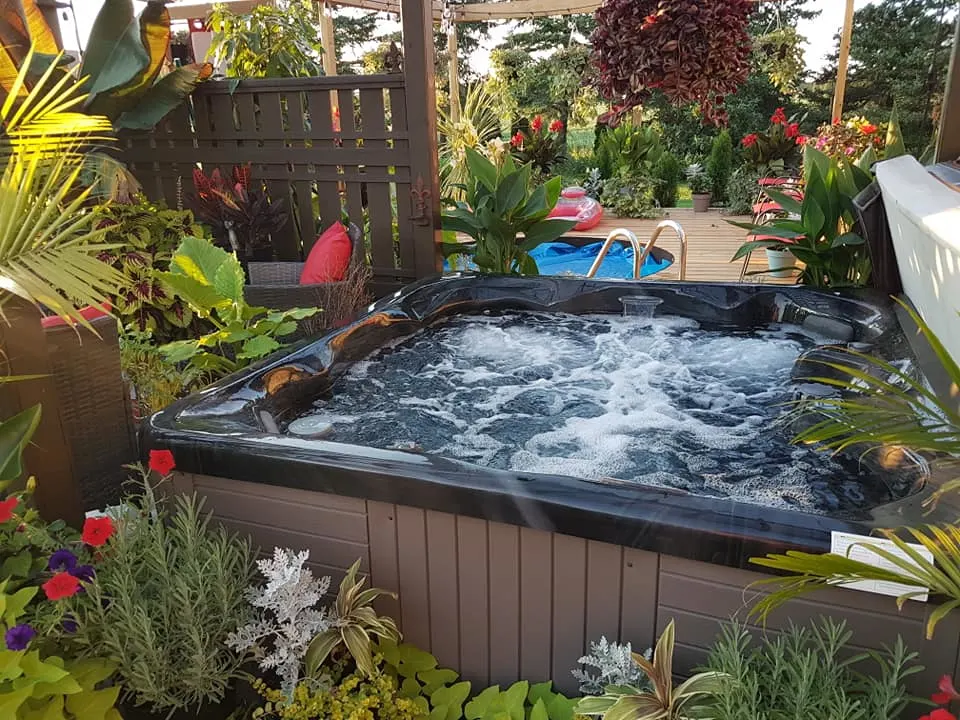The stock tank pool summer trend is all the rage as a great way to cool off in a quick and affordable way. However, did you know that insulating your stock tank pool can elevate your experience?
When you insulate a stock tank pool, you will be able to take advantage of certain benefits such as having to control the water temperature more easily, using it during the colder months, as well as conserving electricity in the long run.
Because of its DIY appeal, a stock tank pool setup can also be incorporated into an aesthetic yet budget-friendly home, such as this rustic barndominium under 200K.
Considering that you already know how to make a stock tank pool, let’s look at why and how to insulate a stock tank pool to maximize its potential for your home.

Source: Lisa Chaykowski (Ottawa, Ontario)
Page Contents
How to Insulate a Stock Tank Pool?
Insulation is key to keeping your pool water at a comfortable temperature all year long. Heat loss is prevented when you insulate a stock tank pool, so you won’t have to spend as much money on heating your pool water.
Properly maintaining a pool may get expensive, and it can account for approximately 30% of household energy consumption for in-ground pools.
Thankfully, stock tank pools are much more energy-efficient and require less power. Insulation is another energy-saving technique that can save you a few bucks, which, in turn, can accumulate to quite large savings over time.
While generally, when you insulate a stock tank pool, it helps the water be kept cool on hot days, this also means that insulation can help keep your pool from freezing over in the winter and is usable when you convert it into a hot tub if you live in a colder climate.
Now that you understand that it’s a great idea to insulate a stock tank pool let us take a look at the methods for doing so.

Source: Lisa Chaykowski (Ottawa, Ontario)
Use a Thick Decorative Fabric
The simplest way to insulate a stock tank pool is by wrapping it with a thick sleeve. You create a jacket for your stock tank to insulate a stock tank pool better.
This is because the metal from the stock tank alone is insufficient to maintain the temperature of the water.
A wide range of fabrics can be purchased online, from wool sleeves to heavy-duty fabrics. You will be able to find a variety of thick fabric patterns that will match your home aesthetic.
Top it off with an insulated pool cover, and your basic pool insulation is good to go!
Suitable for stock tank pools converted to hot tubs, you can use a thick fabric sleeve to maintain your ideal water temperature for a longer period of time, even after usage.
For instance, a pool temperature of over 100 degrees is expected to only drop to the low 90s overnight when the heater is turned off.
Use an Insulation Pad
In most cases, insulation pads are used in walls and ceilings to provide thermal insulation and create a comfortable indoor climate.
That being said, insulation pads are flexible and durable enough to serve the same purpose in stock tank pools as well.
Alternatively, you may have extra thick carpets lying around that you can use to wrap the stock tank pool with instead of buying new insulation pads.
Your stock tank pool can be covered with these thick carpets, which usually have padding that can be ripped and wrapped around it.
Either way, you can decorate your stock tank pool once it has been wrapped by painting the padding or by wrapping it with another material, such as a decorative sleeve or even bamboo fencing.
Use a Foam Board
Using foam board will require you to construct a frame across your stock tank pool for stability, making it the most labor-intensive and the most stable option. This is recommended for stock tank pools that are to be boxed in or placed in the deck.
The frame, typically made of wood, is used to wrap around the stock tank pool, allowing the foam boards to be placed in between.
It is possible to cut and shape foam boards to any shape you desire, and they are a great insulation alternative to fiberglass insulators. Plus, these are moisture-resistant, making them a great DIY stock tank pool insulator.
In order to seal the structure, the frame is boxed with plywood once it has been filled. The insulated stock tank pool setup can then be decorated by painting it, placing decorative tiles, and many other ways.

Source: Carilyn Jacqueline (Southern Ontario, Canada)
Final Thoughts
It is possible to insulate a stock tank pool in a number of ways; however, depending on your preference, the results will vary.
Nevertheless, if your goal is to simply maintain a comfortable temperature after use, even the simple thick fabric wrapping will do a good enough job.
A stock tank pool may be beneficial even in homes that experience colder temperatures, such as this charming Arkansas barndominium, because of the insulation capabilities.
When you install a heater to insulate a stock tank pool, you can also have a winterized makeshift hot tub.
Noah Edis is a passionate staff writer at Barndominium Life, a leading online resource for all things barndominium. With years of experience in the writing industry, Noah has made a name for himself as a skilled storyteller and a knowledgeable authority on the topic of barndominiums.
Noah’s interest in barndominiums began when he stumbled upon the concept while researching alternative housing options. Intrigued by the rustic charm and functionality of these converted barns, he soon became obsessed with the idea of living in one himself. He spent countless hours researching the construction, design, and decorating aspects of barndominiums, and soon became an expert on the topic.
As a staff writer at Barndominium Life, Noah enjoys sharing his knowledge and passion for these unique homes with others. He has written numerous articles covering a wide range of topics, from the history of barndominiums to the best ways to decorate them. Noah’s writing is informative, engaging, and always on-trend, making him a valuable asset to the Barndominium Life team.
Noah is a graduate of the University of British Columbia, where he earned a degree in English Language and Literature. When he’s not writing about barndominiums, he can be found exploring the great outdoors, trying new restaurants, or spending time with his family and friends. Noah is dedicated to his craft and is always striving to improve his writing skills and knowledge of the barndominium lifestyle.
Connect with Noah on LinkedIn
